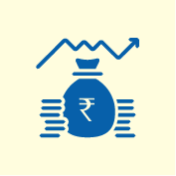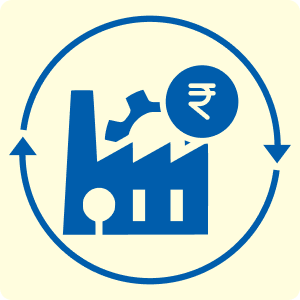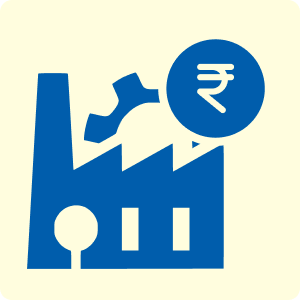You may be eligible for a pre-approved offer
Enter mobile and OTP | Check offer | No branch visit needed
The repo rate is an important tool used by the Reserve Bank of India (RBI) to manage the flow of money in the economy. It directly affects how much interest banks charge on loans and offer on deposits. When the RBI changes the repo rate, your loan EMIs can go up or down, and the returns on your savings can also be influenced. Understanding the current repo rate helps you see how these changes might affect your personal finances and spending decisions.
The repo rate plays an important role in how personal loan interest rates are decided. When the repo rate changes, it can impact your loan cost and monthly EMI. You can check your personal loan eligibility using just your mobile number and OTP through a 100% online process.
What is repo rate?
The repo rate is the interest rate at which the RBI lends short-term funds to commercial banks against government securities. When the repo rate increases, borrowing becomes more expensive for banks, which may lead to higher interest rates on loans like personal, car, or home loans. Conversely, a lower repo rate reduces borrowing costs, allowing banks to offer loans at cheaper rates. The RBI uses the repo rate as a key tool to manage inflation, regulate money flow, and maintain overall economic stability.
How does the repo rate work?
The repo rate is the rate at which the RBI lends short-term funds to banks against government securities.
Banks use this option when they need additional liquidity to manage daily operations.
- When the RBI raises the repo rate:
- Borrowing from the RBI becomes more expensive for banks.
Banks may respond by increasing the interest rates on loans offered to customers.
- When the RBI lowers the repo rate:
- Banks can access funds at a lower cost.
This often encourages banks to reduce interest rates on loans.
- The RBI adjusts the repo rate to manage inflation, money supply, and overall financial stability in the country.
What is the current repo rate in India?
The current repo rate in India is 5.25%, revised after a recent rate cut by the Reserve Bank of India. This is the rate at which the RBI provides short-term funds to commercial banks against government securities, helping them manage day-to-day liquidity needs. The reverse repo rate, which is the rate at which banks deposit their surplus funds with the RBI, remains at 3.35%. Both these policy rates directly influence loan interest rates, inflation control, and overall liquidity in the financial system. The RBI’s Monetary Policy Committee reviews these rates regularly and adjusts them based on changing economic conditions and inflation trends to maintain financial stability.
Reserve Bank of India repo rate
The repo rate is the rate at which the Reserve Bank of India (RBI) lends money to commercial banks when they need short-term funds. In return, banks give government securities as collateral. This rate plays a key role in the country’s economy. It affects how much banks charge us for loans, helps the RBI keep inflation in check, and ensures there’s enough liquidity (cash flow) in the financial system. As of December 2025, the current repo rate is 5.25%, after the RBI reduced it to support growth and maintain price stability.
| Repo Rate Today | 5.25% |
| Reverse Repo Rate | 3.35% |
Historical repo rates from 2010 to 2025
Here's a table showing the historical repo rates set by the Reserve Bank of India (RBI) from 2010 to 2025. These rates reflect the RBI's response to various economic conditions over the years and tracking the repo rate effect can reveal several insights.
| Year | Repo Rate (%) |
| 2025 | 5.25 |
| 2024 | 6.5 |
| 2023 | 6.25 |
| 2022 | 4.40 – 5.90 |
| 2021 | 4 |
| 2020 | 4 |
| 2019 | 5.15 – 6.25 |
| 2018 | 6.25 – 6.50 |
| 2017 | 6 |
| 2016 | 6.5 |
| 2015 | 6.75 |
| 2014 | 7.75 – 8.00 |
| 2013 | 7.25 – 8.00 |
| 2012 | 8.00 – 8.50 |
| 2011 | 6.50 – 8.50 |
| 2010 | 5.25 – 6.25 |
Why is the repo rate important?
The repo rate plays a big role in how money moves in the economy. Here’s why it matters:
1. It affects loan interest rates
If the repo rate increases, borrowing becomes costlier for banks—and for you. Loan EMIs can go up. If it drops, loans may get cheaper.
2. It helps control inflation
When inflation is high, the RBI raises the repo rate to make borrowing expensive. This slows down spending. When inflation is low, the RBI can lower the rate to boost demand.
3. It supports economic growth
Lower repo rates make loans more affordable, which helps businesses grow and encourages people to spend more—giving the economy a push.
4. It impacts investments and savings
Changes in the repo rate also affect returns on savings and investments. So staying updated helps you make better financial decisions.
How does RBI calculate repo rate?
The RBI calculates the repo rate based on several economic factors to control inflation and support economic growth. Key considerations include:
- Inflation trends: High inflation generally prompts the RBI to increase the repo rate, while low inflation may lead to a reduction.
- Economic growth: The repo rate is adjusted to balance economic growth with inflation control, ensuring stability.
- Liquidity and banking needs: The demand for loans and the money supply influence repo rate adjustments.
- External economic influences: Global factors like commodity prices and international market fluctuations also impact the decision.
The RBI evaluates these factors during its regular monetary policy reviews to determine the most appropriate rate.
What is reverse repo rate?
The reverse repo rate is the interest rate at which the RBI borrows money from commercial banks, usually by offering government securities in return.
When banks have extra money lying around, they can lend it to the RBI and earn interest at this rate. This gives banks a safe option to park their surplus funds instead of giving out more loans.
By doing this, the RBI can reduce the amount of money flowing in the system, which helps keep inflation in check. In simple terms, the reverse repo rate helps the RBI manage how much cash is available in the economy and keep things stable.
What is the difference between repo rate and reverse repo rate?
The repo rate is the interest rate at which the Reserve Bank of India (RBI) lends funds to commercial banks against government securities, helping manage inflation. The reverse repo rate is the interest paid by the RBI to banks on their surplus deposits, helping control liquidity in the economy. While the repo rate generates income by lending to banks, the reverse repo earns interest on deposits. The reverse repo rate is always lower than the repo rate.
Here is a summary of repo rate vs reverse repo rate:
| Aspect | Repo rate | Reverse repo rate |
| Role | Injects liquidity into the economy | Absorbs excess liquidity |
| Who benefits? | Banks borrowing funds from RBI | Banks depositing surplus funds with RBI |
| Impact on lending | Directly influences loan interest rates | Indirectly influences liquidity availability |
| Monetary policy tool | Used mainly to control inflation and stimulate growth | Used mainly to control liquidity and stabilize money supply |
| Effect on money supply | Increases money supply when rate is low | Decreases money supply by absorbing excess funds |
| Central bank income | RBI earns interest by lending funds | RBI pays interest to banks on deposits |
| Economic effect | Higher repo rate slows down economy | Higher reverse repo rate encourages banks to save more |
What is affected by a change in repo rate?
A change in the repo rate can impact several key areas of the economy:
- Loan costs: Higher repo rate means costlier loans and EMIs; a lower rate makes borrowing cheaper.
- Inflation: Raising the rate helps control inflation; lowering it boosts spending.
- Investments: Low rates push money to stocks; high rates favour fixed deposits.
- Currency strength: A higher rate attracts foreign investment, strengthening the rupee.
These factors collectively shape the economic environment, influencing everything from individual borrowing costs to national growth rates.
Impact of repo rate on consumers
Changes in the repo rate have a direct effect on consumers in several ways:
- Loan costs: A rise in the repo rate increases the interest rates on loans like home loans, personal loans, and car loans, making borrowing costlier for consumers. Conversely, a decrease in the repo rate lowers loan costs, encouraging borrowing and investment.
- Savings returns: When the repo rate increases, banks tend to offer higher interest rates on deposits, benefiting savers. Lower repo rates may reduce returns on savings.
- Inflation: The repo rate influences inflation; an increase typically helps control rising prices, while a reduction can increase demand, potentially leading to inflationary pressures.
In essence, consumers' borrowing and saving patterns are significantly influenced by fluctuations in the repo rate.
What is the relationship between inflation and repo rate
The repo rate and inflation are closely linked.
- When inflation is high, the RBI increases the repo rate. This makes loans more expensive, so people borrow and spend less. As a result, inflation comes down.
- When inflation is low, the RBI lowers the repo rate. This makes loans cheaper, encouraging people to borrow and spend more—giving the economy a boost.
In short, the RBI uses the repo rate to keep inflation under control and maintain economic balance.
How repo rate impacts personal loan EMI?
The repo rate primarily affects loans with floating interest rates, while personal loans are often offered at fixed rates. This means that existing personal loan borrowers may not feel the impact immediately after a repo rate change.
When the RBI increases the repo rate, banks and NBFCs face higher borrowing costs. To maintain profit margins, they usually raise personal loan interest rates, which increases EMIs for borrowers. Conversely, when the RBI lowers the repo rate, banks can borrow at lower costs and may offer personal loans at reduced interest rates, making EMIs more affordable.
It is important to note that repo rate changes do not affect personal loan EMIs immediately. Banks take some time to revise interest rates after the RBI announces a change. Borrowers should monitor repo rate movements and maintain a good credit score and repayment history to secure personal loans at better interest rates when rates are favourable.
How repo rate impacts fixed deposits?
The repo rate influences fixed deposit interest rates. When the central bank raises the repo rate, banks may increase fixed deposit rates to attract funds, offering better returns to depositors. Conversely, a lower repo rate might lead to lower fixed deposit rates, impacting returns for investors.
How repo rate affects economy?
The repo rate impacts the economy by influencing interest rates. A higher repo rate can lead to increased borrowing costs, slowing economic activity and inflation. Conversely, a lower repo rate stimulates borrowing, promoting spending and investment. Central banks use repo rate adjustments as a tool to achieve monetary policy objectives and economic stability.
- Controlling Inflation: When prices start rising too fast, the RBI raises the repo rate. This makes loans more expensive, so people and businesses tend to borrow and spend less, which helps slow down inflation.
- Boosting growth: On the other hand, when the economy needs a push, the RBI lowers the repo rate. Cheaper loans encourage businesses and individuals to borrow, invest, and spend more, giving the economy a much-needed boost
- Liquidity management: The repo rate helps the RBI control the availability of funds in the banking system. An increased repo rate reduces liquidity, while a lower rate increases it.
- Investment patterns: Lower repo rates can attract investors to equities and real estate as they seek higher returns, while higher rates can shift investments to safer, fixed-income options.
- Loan repayment costs: A high repo rate makes loans costlier, affecting EMIs on home, personal, and auto loans, which can impact household budgets and consumption.
How repo rate affects stock market?
The repo rate influences the stock market by affecting borrowing costs. When the central bank raises the repo rate, it can increase interest rates, making borrowing more expensive for businesses. This may impact corporate earnings and stock valuations, potentially leading to market adjustments. Conversely, a lower repo rate may stimulate economic activity and benefit stocks.
Use the personal loan EMI calculator to swiftly calculate your monthly payments on personal loans.
Conclusion
The repo rate is an important tool the RBI uses to manage inflation, encourage investment, and support economic growth. By raising or lowering the repo rate, the RBI can either slow down or speed up economic activity as needed. Along with the reverse repo rate, it helps control the flow of money in the market, affecting loan interest rates and the overall health of the economy. Knowing how the repo rate works can help borrowers and investors make smarter choices about loans and investments.
Key offerings: 3 loan types
Personal loan interest rate and applicable charges
Type of fee |
Applicable charges |
Rate of interest per annum |
10% to 31% p.a. |
Processing fees |
Up to 3.93% of the loan amount (inclusive of applicable taxes). |
Flexi Facility Charge |
Term Loan – Not applicable Flexi Loans –Up To Rs 1,999 To Up To Rs 18,999/- (Inclusive Of Applicable Taxes) |
Bounce charges |
Rs. 700 to Rs. 1,200/- per bounce “Bounce Charges” shall mean charges levied on each instance in the event of: (i) dishonour of any payment instrument irrespective of whether the customer subsequently makes the payment through an alternate mode or channel on the same day; and/or (ii) non-payment of instalment(s) on their respective due dates where any payment instrument is not registered/furnished; and/or (iii) rejection or failure of mandate registration by the customer’s bank. |
Part-prepayment charges |
Full Pre-payment: |
Penal charge |
Delay in payment of instalment(s) shall attract Penal Charge at the rate of up to 36% per annum per instalment from the respective due date until the date of receipt of the full instalment(s) amount. |
Stamp duty (as per respective state) |
Payable as per state laws and deducted upfront from loan amount. |
Annual maintenance charges |
Term Loan: Not applicable Flexi Term (Dropline) Loan: Up to 0.30% (Inclusive of applicable taxes) of the Dropline limit (as per the repayment schedule) on the date of levy of such charges.
Up to 0.30% (Inclusive Of Applicable Taxes) Of The Dropline Limit During Initial Tenure. Up to 0.30% (Inclusive Of Applicable Taxes) Of Dropline Limit During Subsequent Tenure |
Related articles
Disclaimer
Bajaj Finance Limited has the sole and absolute discretion, without assigning any reason to accept or reject any application. Terms and conditions apply*.
For customer support, call Personal Loan IVR: 7757 000 000









 Personal Loan
Personal Loan Check Eligibility
Check Eligibility Salaried Personal Loan
Salaried Personal Loan EMI Calculator
EMI Calculator Account Aggregator
Account Aggregator Credit Pulse Report
Credit Pulse Report
 Deals starting @99
Deals starting @99 Min. 50% off
Min. 50% off
 Bajaj Pay
Bajaj Pay Wallet to Bank
Wallet to Bank
 Easy EMI Loan
Easy EMI Loan Savings Offer
Savings Offer Smartphones
Smartphones Led TVs
Led TVs Washing Machines
Washing Machines Laptops
Laptops Refrigerators
Refrigerators Air Conditioner
Air Conditioner Air Coolers
Air Coolers
 Loan Against Shares
Loan Against Shares Loan Against Mutual Funds
Loan Against Mutual Funds Loan Against Insurance Policy
Loan Against Insurance Policy ESOP Financing
ESOP Financing Easy EMI Loan
Easy EMI Loan Two-wheeler Loan
Two-wheeler Loan Loan for Lawyer
Loan for Lawyer Industrial Equipment Finance
Industrial Equipment Finance Industrial Equipment Balance Transfer
Industrial Equipment Balance Transfer Industrial Equipment Refinance
Industrial Equipment Refinance Personal Loan Branch Locator
Personal Loan Branch Locator Used Tractor Loan
Used Tractor Loan Loan Against Tractor
Loan Against Tractor Tractor Loan Balance Transfer
Tractor Loan Balance Transfer Flexi
Flexi View All
View All
 Two-wheeler Loan
Two-wheeler Loan Bike
Bike Scooter
Scooter Electric Vehicle
Electric Vehicle Best Sellers
Best Sellers Popular Brands
Popular Brands

 Trading Account
Trading Account Open Demat Account
Open Demat Account Margin Trading Financing
Margin Trading Financing Share Market
Share Market Invest in IPO
Invest in IPO All stocks
All stocks Top gainers
Top gainers Top losers
Top losers 52 week high
52 week high 52 week low
52 week low Loan against shares
Loan against shares
 Home Loan
Home Loan Transfer your existing Home loan
Transfer your existing Home loan Loan against Property
Loan against Property Home Loan for Salaried
Home Loan for Salaried Home loan for self employed
Home loan for self employed Loan Against Property Balance Transfer
Loan Against Property Balance Transfer Home Loan EMI Calculator
Home Loan EMI Calculator Home Loan eligibility calculator
Home Loan eligibility calculator Home Loan balance transfer
Home Loan balance transfer View All
View All
 Term Life Insurance
Term Life Insurance ULIP Plan
ULIP Plan Savings Plan
Savings Plan Family Insurance
Family Insurance Senior Citizen Health Insurance
Senior Citizen Health Insurance Critical Illness Insurance
Critical Illness Insurance Child Health Insurance
Child Health Insurance Pregnancy and Maternity Health Insurance
Pregnancy and Maternity Health Insurance Individual Health Insurance
Individual Health Insurance Low Income Health Insurance
Low Income Health Insurance Student Health Insurance
Student Health Insurance Group Health Insurance
Group Health Insurance Retirement Plans
Retirement Plans Child Plans
Child Plans Investment Plans
Investment Plans
 Business Loan
Business Loan Secured Business Loan
Secured Business Loan Loan against property
Loan against property Loans against property balance transfer
Loans against property balance transfer Loan against shares
Loan against shares Home Loan
Home Loan Loans against mutual funds
Loans against mutual funds Loan against bonds
Loan against bonds Loan against insurance policy
Loan against insurance policy
 Apply for Gold Loan
Apply for Gold Loan Transfer your Gold Loan with Us
Transfer your Gold Loan with Us Gold Loan Branch Locator
Gold Loan Branch Locator
 ULIP Plan
ULIP Plan Savings Plan
Savings Plan Retirement Plans
Retirement Plans Child Plans
Child Plans Free Demat Account
Free Demat Account Invest in Stocks
Invest in Stocks Invest in IPO
Invest in IPO Margin Trading Facility
Margin Trading Facility Fixed Deposit Branch Locator
Fixed Deposit Branch Locator
 Check your Credit Score
Check your Credit Score
 New Car Loan
New Car Loan Used Car Loan
Used Car Loan Loan Against Car
Loan Against Car Car Loan Balance Transfer and Top-up
Car Loan Balance Transfer and Top-up My Garage
My Garage
 Get Bajaj Prime
Get Bajaj Prime
 Mobiles on EMI
Mobiles on EMI Electronics on EMI Offer
Electronics on EMI Offer  Iphone on EMI
Iphone on EMI LED TV on EMI
LED TV on EMI Refrigerator on EMI
Refrigerator on EMI Laptop on EMI
Laptop on EMI Kitchen appliances on EMI
Kitchen appliances on EMI Washing machines
Washing machines
 Personal Loan EMI Calculator
Personal Loan EMI Calculator Personal Loan Eligibility Calculator
Personal Loan Eligibility Calculator Home Loan EMI Calculator
Home Loan EMI Calculator Home Loan Eligibility Calculator
Home Loan Eligibility Calculator Good & Service Tax (GST) Calculator
Good & Service Tax (GST) Calculator Flexi Day Wise Interest Calculator
Flexi Day Wise Interest Calculator Flexi Transaction Calculator
Flexi Transaction Calculator Secured Business Loan Eligibility Calculator
Secured Business Loan Eligibility Calculator Fixed Deposits Interest Calculator
Fixed Deposits Interest Calculator Two wheeler Loan EMI Calculator
Two wheeler Loan EMI Calculator New Car Loan EMI Calculator
New Car Loan EMI Calculator Used Car Loan EMI Calculator
Used Car Loan EMI Calculator All Calculator
All Calculator Used Tractor Loan EMI Calculator
Used Tractor Loan EMI Calculator
 Hot Deals
Hot Deals Clearance Sale
Clearance Sale Kitchen Appliances
Kitchen Appliances Tyres
Tyres Camera & Accessories
Camera & Accessories Mattresses
Mattresses Furniture
Furniture Watches
Watches Music & Audio
Music & Audio Cycles
Cycles Mixer & Grinder
Mixer & Grinder Luggage & Travel
Luggage & Travel Fitness Equipment
Fitness Equipment Fans
Fans
 Personal Loan for Doctors
Personal Loan for Doctors Business loan for Doctors
Business loan for Doctors Home Loan
Home Loan Secured Business Loan
Secured Business Loan Loan against property
Loan against property Secured Business Loan Balance Transfer
Secured Business Loan Balance Transfer Loan against share
Loan against share Gold Loan
Gold Loan Medical Equipment Finance
Medical Equipment Finance
 Smart Hub
Smart Hub ITR Service
ITR Service Digi Sarkar
Digi Sarkar
 Savings Offer
Savings Offer Easy EMI
Easy EMI Offer World
Offer World 1 EMI OFF
1 EMI OFF New Launches
New Launches Zero Down Payment
Zero Down Payment Clearance Sale
Clearance Sale Bajaj Mall Sale
Bajaj Mall Sale
 Mobiles under ₹20,000
Mobiles under ₹20,000 Mobiles under ₹25,000
Mobiles under ₹25,000 Mobiles under ₹30,000
Mobiles under ₹30,000 Mobiles under ₹35,000
Mobiles under ₹35,000 Mobiles under ₹40,000
Mobiles under ₹40,000 Mobiles under ₹50,000
Mobiles under ₹50,000
 Articles
Articles
 Overdue Payments
Overdue Payments Other Payments
Other Payments
 Document Center
Document Center Bank details & Documents
Bank details & Documents Tax Invoice Certificate
Tax Invoice Certificate
 Do Not Call Service
Do Not Call Service
 Hamara Mall Orders
Hamara Mall Orders

 Fixed Deposit (IFA) Partner
Fixed Deposit (IFA) Partner Loan (DSA) Partner
Loan (DSA) Partner Debt Management Partner
Debt Management Partner EMI Network Partner
EMI Network Partner Became a Merchant
Became a Merchant Partner Sign-in
Partner Sign-in
 Trade directly with your Demat A/c
Trade directly with your Demat A/c ITR
ITR My Garage
My Garage
 Live Videos - Beta
Live Videos - Beta
 Savings Offer
Savings Offer Smartphones
Smartphones LED TVs
LED TVs Washing Machines
Washing Machines Laptops
Laptops Refrigerators
Refrigerators Air Conditioners
Air Conditioners Air Coolers
Air Coolers Water Purifiers
Water Purifiers Tablets
Tablets Kitchen Appliances
Kitchen Appliances Mattresses
Mattresses Furniture
Furniture Music and Audio
Music and Audio Cameras & Accessories
Cameras & Accessories Cycle
Cycle Watches
Watches Tyres
Tyres Luggage & Travel
Luggage & Travel Fitness Equipment
Fitness Equipment Tractor
Tractor Easy EMI Loan
Easy EMI Loan
 vivo Mobiles
vivo Mobiles OPPO Mobiles
OPPO Mobiles Xiaomi Mobiles
Xiaomi Mobiles Sony LED TVs
Sony LED TVs Samsung LED TVs
Samsung LED TVs LG LED TVs
LG LED TVs Haier LED TVs
Haier LED TVs Godrej Refrigerators
Godrej Refrigerators Voltas Washing Machines
Voltas Washing Machines
 New Tractor Loan
New Tractor Loan Used Tractor Loan
Used Tractor Loan Loan Against Tractor
Loan Against Tractor Tractor Loan Balance Transfer
Tractor Loan Balance Transfer
 New Car Loan
New Car Loan New Cars Under ₹10 Lakh
New Cars Under ₹10 Lakh New Cars – ₹10–₹15 Lakh
New Cars – ₹10–₹15 Lakh New Cars – ₹15–₹20 Lakh
New Cars – ₹15–₹20 Lakh New Cars – ₹20–₹25 Lakh
New Cars – ₹20–₹25 Lakh New Car Brands
New Car Brands Petrol – New Cars
Petrol – New Cars Diesel – New Cars
Diesel – New Cars Electric – New Cars
Electric – New Cars CNG – New Cars
CNG – New Cars Hybrid – New Cars
Hybrid – New Cars










